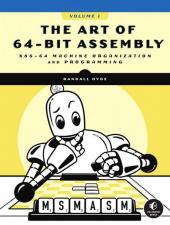Download Chapter 6: ARITHMETIC
Randall Hyde's The Art of Assembly Language has long been the go-to guide for learning assembly language. In this long-awaited follow-up, Hyde presents a 64-bit rewrite of his seminal text. It not only covers the instruction set for today’s x86-64 class of processors in-depth (using MASM), but also leads you through the maze of assembly language programming and machine organization by showing you how to write code that mimics operations in high-level languages.
Beginning with a “quick-start” chapter that gets you writing basic ASM applications as rapidly as possible, Hyde covers the fundamentals of machine organization, computer data representation and operations, and memory access. He’ll teach you assembly language programming, starting with basic data types and arithmetic, progressing through control structures and arithmetic to advanced topics like table lookups and string manipulation. In addition to the standard integer instruction set, the book covers the x87 FPU, single-instruction, multiple-data (SIMD) instructions, and MASM’s very powerful macro facilities. Throughout, you’ll benefit from a wide variety of ready-to-use library routines that simplify the programming process.
You’ll learn how to:
- Write standalone programs or link MASM programs with C/C++ code for calling routines in the C Standard Library
- Organize variable declarations to speed up access to data, and how to manipulate data on the x86-64 stack
- Implement HLL data structures and control structures in assembly language
- Convert various numeric formats, like integer to decimal string, floating-point to string, and hexadecimal string to integer
- Write parallel algorithms using SSE/AVX (SIMD) instructions
- Use macros to reduce the effort needed to write assembly language code
The Art of 64-bit Assembly, Volume 1 builds on the timeless material of its iconic predecessor, offering a comprehensive masterclass on writing complete applications in low-level programming languages.

